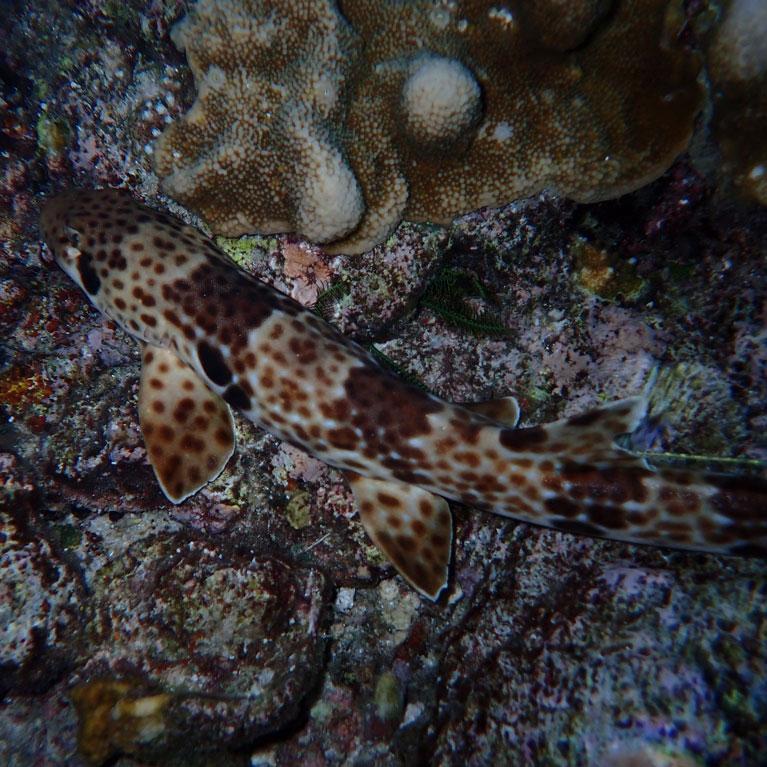Tracking declines in protected waters
The Raja Ampat epaulette shark can be found in the protected waters of the Raja Ampat Marine Protected Area in Indonesia. A Near Threatened species, it is endemic (found nowhere else in the world) to this region. But even havens now show our human footprint: Muhammad is investigating reports of declines in the epaulette shark’s population here, where the impact of tourism in the form of development and boat traffic might be impacting these sharks. He’s updating the information about the population, its distribution and threats to it to ensure these sharks are managed both inside and outside the marine protected area.
I was born and raised in Jakarta, the capital of Indonesia. My interest in the ocean began when I was a child and I watched ocean and wildlife animal documentaries on television every day. Because of these I grew to love the ocean and decided to study marine science. In my early years at university, my interest was marine conservation, with a particular focus on elasmobranchs (sharks and rays). While learning about elasmobranchs in class, outside the classroom I worked with GAIA Conservation, a local community that focuses on the conservation of marine megafauna. I also took...


Assessing the population, distribution, and conservation status of Raja Ampat Epaulette Shark in West Papua
To improve the conservation of the Raja Ampat epaulette shark in Raja Ampat Islands by studying the species’ ecology and providing scientific and evidence-based recommendations to stakeholders to enable them to plan how to manage and protect it. We also aim to promote citizen science as a long-term effort to conserve the species.
Despite the Raja Ampat epaulette shark’s conservation status of Near Threatened and its occurrence in the Raja Ampat Marine Protected Area, its population is declining due to pressure from fisheries and habitat degradation caused by tourism development. However, the species is poorly studied in Indonesia. This project will provide information about the shark’s ecology and promote citizen science as a long-term conservation effort to support stakeholders’ initiatives to protect the species.
The Raja Ampat epaulette shark Hemiscyllium freycineti is endemic to the Raja Ampat Islands of West Papua, Indonesia. Although it is classified as Near Threatened, its population is believed to be declining, based on anecdotal reports over the past five years that suggest the construction of tourist accommodation and the disturbance caused by boat traffic over reef flats are impacting the sharks. Degradation of the species’ reef-flat habitat also occurs in approximately 20% of its distribution range due to the combination of tourism development and climate change. Furthermore, the fact that these sharks are found only over shallow sea-grass beds, coral reefs and rocky outcrops at a maximum depth of 10 metres (33 feet) means that their distribution in Raja Ampat is likely to be restricted by trenches and deep water between islands. The species has a significant level of protection, with 80% of its range located within a network of marine protected areas and its full range safeguarded by Raja Ampat Regency Law No. 9/2012. Despite its distribution in some marine protected areas, however, it is believed to still face pressure from artisanal fishing, including by hand line from about 120 villages throughout its range. Collection for the aquarium trade may also be a factor in its decline, although the exact effect of this is not known. Research into this species has been limited since it was first observed in 2003. More is needed to learn about its population and distribution and the threats it faces so that it can be better managed, whether it occurs inside or outside marine protected areas.
- To collect information about the population of Raja Ampat epaulette sharks and their distribution in Yenbuba and Arborek, Raja Ampat Islands, using capture-mark-recapture and photo-identification methods.
- To build a local database of Raja Ampat epaulette sharks using the Interactive Individual Identification System (I3S), HotSpotter tools and manual verification.
- To create a citizen science platform page and guidelines specifically for the Raja Ampat epaulette shark on Elasmobranch Project Indonesia’s website and in scientific, evidence-based management recommendations for the species’ conservation to stakeholders.

